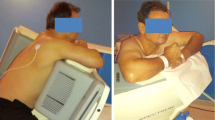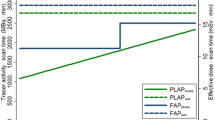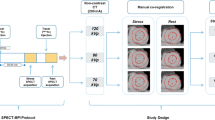Abstract
Background
For a 1-day myocardial perfusion SPECT (MPS) the recommendations for administered activity stated in the EANM guidelines results in an effective dose of up to 16 mSv per patient. Recently, a gamma camera system, based on cadmium zinc telluride (CZT) technology, was introduced. This technique has the potential to reduce the effective dose and scan time compared to the conventional NaI gamma camera. The aim of this study was to investigate if the effective dose can be reduced with a preserved image quality using CZT technology in MPS.
Methods
In total, 150 patients were included in the study. All underwent a 1-day 99mTc-tetrofosmin stress-rest protocol and were divided into three subgroups (n = 50 in each group) with 4, 3, and 2.5 MBq/kg body weight of administered activity in the stress examination, respectively. The acquisition time was increased in proportion to the decrease in administered activity. All examinations were analyzed for image quality by visual grading on a 4-point scale (1 = poor, 2 = adequate, 3 = good, 4 = excellent), by two expert readers.
Results
The total effective dose (stress + rest) decreased from 9.3 to 5.8 mSv comparing 4 to 2.5 MBq/kg body weight. For the patients undergoing stress examination only (35%) the effective dose, administrating 2.5 MBq/kg, was 1.4 mSv. The image acquisition times for 2.5 MBq/kg body weight were 475 and 300 seconds (stress and rest) compared to 900 seconds for each when using conventional MPS. The average image quality was 3.7 ± 0.5, 3.8 ± 0.5, and 3.8 ± 0.4 for the stress images and 3.5 ± 0.6, 3.6 ± 0.6, and 3.5 ± 0.6 for the rest images and showed no statistically significant difference (P = .62) among the 4, 3, and 2.5 MBq/kg groups.
Conclusions
The new CZT technology can be used to considerably decrease the effective dose and acquisition time for MPS with preserved high image quality.



Similar content being viewed by others
References
Bocher M, Blevis IM, Tsukerman L, Shrem Y, Kovalski G, Volokh L. A fast cardiac gamma camera with dynamic SPECT capabilities: Design, system validation and future potential. Eur J Nucl Med Mol Imaging 2010;37:1887-902. doi:10.1007/s00259-010-1488-z.
Gambhir SS, Berman DS, Ziffer J, Nagler M, Sandler M, Patton J, et al. A novel high-sensitivity rapid-acquisition single-photon cardiac imaging camera. J Nucl Med 2009;50:635-43. doi:10.2967/jnumed.108.060020.
Berman DS, Kang X, Tamarappoo B, Wolak A, Hayes SW, Nakazato R, et al. Stress thallium-201/rest technetium-99m sequential dual isotope high-speed myocardial perfusion imaging. JACC Cardiovasc Imaging 2009;2:273-82. doi:10.1016/j.jcmg.2008.12.012.
Buechel RR, Herzog BA, Husmann L, Burger IA, Pazhenkottil AP, Treyer V, et al. Ultrafast nuclear myocardial perfusion imaging on a new gamma camera with semiconductor detector technique: First clinical validation. Eur J Nucl Med Mol Imaging 2010;37:773-8. doi:10.1007/s00259-009-1375-7.
Esteves FPRP, Folks RD, Keidar Z, Askew JW, Rispler S, O’Connor MK, et al. Novel solid-state-detector dedicated cardiac camera for fast myocardial perfusion imaging: Multicenter comparison with standard dual detector cameras. J Nucl Cardiol 2009;16:927-34.
Herzog BA, Buechel RR, Katz R, Brueckner M, Husmann L, Burger IA, et al. Nuclear myocardial perfusion imaging with a cadmium-zinc-telluride detector technique: Optimized protocol for scan time reduction. J Nucl Med 2010;51:46-51. doi:10.2967/jnumed.109.065532.
Sharir T, Ben-Haim S, Merzon K, Prochorov V, Dickman D, Berman DS. High-speed myocardial perfusion imaging initial clinical comparison with conventional dual detector anger camera imaging. JACC Cardiovasc Imaging 2008;1:156-63. doi:10.1016/j.jcmg.2007.12.004.
Hesse B, Lindhardt TB, Acampa W, Anagnostopoulos C, Ballinger J, Bax JJ, et al. EANM/ESC guidelines for radionuclide imaging of cardiac function. Eur J Nucl Med Mol Imaging 2008;35:851-85. doi:10.1007/s00259-007-0694-9.
Hesse B, Tagil K, Cuocolo A, Anagnostopoulos C, Bardies M, Bax J, et al. EANM/ESC procedural guidelines for myocardial perfusion imaging in nuclear cardiology. Eur J Nucl Med Mol Imaging 2005;32:855-97. doi:10.1007/s00259-005-1779-y.
Holly TA, Abbott BG, Al-Mallah M, Calnon DA, Cohen MC, DiFilippo FP, et al. Single photon-emission computed tomography. J Nucl Cardiol 2010;17:941-73. doi:10.1007/s12350-010-9246-y.
Gerber TC, Gibbons RJ. Weighing the risks and benefits of cardiac imaging with ionizing radiation. JACC Cardiovasc Imaging 2010;3:528-35. doi:10.1016/j.jcmg.2010.03.003.
Eisenberg MJ, Afilalo J, Lawler PR, Abrahamowicz M, Richard H, Pilote L. Cancer risk related to low-dose ionizing radiation from cardiac imaging in patients after acute myocardial infarction. CMAJ 2011;183:430-6. doi:10.1503/cmaj.100463.
Duvall WL, Croft LB, Ginsberg ES, Einstein AJ, Guma KA, George T, et al. Reduced isotope dose and imaging time with a high-efficiency CZT SPECT camera. J Nucl Cardiol 2011;18:847-57. doi:10.1007/s12350-011-9379-7.
ICRP Publication 106: Radiation dose to patients from radiopharmaceuticals (Addendum 3 to ICRP publication 53). Ann ICRP 2008;38:1-197.
Cerqueira MD, Allman KC, Ficaro EP, Hansen CL, Nichols KJ, Thompson RC, et al. Recommendations for reducing radiation exposure in myocardial perfusion imaging. J Nucl Cardiol 2010;17:709-18. doi:10.1007/s12350-010-9244-0.
ICRP Publication 105. Radiation protection in medicine. Ann ICRP 2007;37:1-63. doi:10.1016/j.icrp.2008.08.001.
Acknowledgments
The authors would like to thank Christel Kullberg for excellent technical assistance. This study was supported in part by research funding from Region of Scania, Swedish Research Council, Swedish Heart and Lung Foundation, and Lund University Faculty of Medicine.
Conflict of interest
None.
Author information
Authors and Affiliations
Corresponding author
Rights and permissions
About this article
Cite this article
Oddstig, J., Hedeer, F., Jögi, J. et al. Reduced administered activity, reduced acquisition time, and preserved image quality for the new CZT camera. J. Nucl. Cardiol. 20, 38–44 (2013). https://doi.org/10.1007/s12350-012-9634-6
Received:
Accepted:
Published:
Issue Date:
DOI: https://doi.org/10.1007/s12350-012-9634-6




